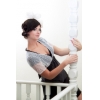|
 The epoch of '40s of the twenties century turned out to be clearly divided into two parts. The first half of the decade was full of hardships
and privation of the war times, while the second half was marked by the real
revolution in fashion, to some extent more significant than the revolution done
some time back by Coco Chanel. The epoch of '40s of the twenties century turned out to be clearly divided into two parts. The first half of the decade was full of hardships
and privation of the war times, while the second half was marked by the real
revolution in fashion, to some extent more significant than the revolution done
some time back by Coco Chanel.
The revolution
if fashion was presented by the famous collection New Look launched by the French
couturier Christian Dior which still symbolizes the new hopes of post-war epoch
and the role model to that most fashion designers refer from time to time.
World War II fashion
It is apparent
that during the war times women could not afford spending incredible
amount of money
for fashionable clothes for several reasons. First, the oppressive
economy when
everything possible was saved and which was followed by all countries
involved
in the war. And the half-starving times had an affect onto the every
day life
of women with the system of coupons introduced in some countries of
Europe and USA, the
consumption of clothes and even food was totally controlled. On the top
of it, with
the purpose to save fabric and fittings in the early 40s, in the high
point of the World War II, the USA and Great Britain introduced the
special laws that limit the creative ideas of fashion designers. They
were charged
to launch exclusively practical models and save on fabric.
There is nothing
surprising that within a couple of years the most popular piece of clothing in
the civil society, leaving aside the army, appeared the military uniform for
both men and women. Women wore austere military suits even going out to the
cinema or restaurant emphasizing the adherence to the army and showing the
willingness to scarify everything for the sake of victory.
On June 1, 1941
the Great Britain
initiated the system of coupons that has to do with the clothes. The
similar system was practiced in USA in 1942. The government of Great
Britain seeking to the profit-proved
consumption of materials freezed usage of unwanted decorations and
embroidery,
buttons, pockets and even thread!
The British
designers had to do strictly in the frame of the program of the war economy, though
there were talented individuals who managed to meet the requirements of women
regarding fashionable clothes during hard days. This resulted in the special
military collection that included 34 pieces of clothing, economical from point
of view of production and later approved by the Ministry of Trade of Great Britain.
The clothes
presented by British designers went after the total trend of minimalism
stipulated by war times: the shoulders were rigorous and square, skirts were
short to use minimum of fabric. Creating such apparel, the designers would save
on every detail, even on buttons the quantity of which was minimized to three. Women
suits and dresses got rid of cuffs.
New epoch
and New Look
February
12, 1947 became the remarkable day for the world of fashion. Christian Dior
launched his first collection of women wear spring-summer 1947 at the Christian
Dior salon on Montaigne Avenue.
Two lines of wear earlier presented by Dior were called Corolla and Eight and
the collections went down in the history as New Look thanks to Carmel Snow
heading the legendary Harper’s Bazaar. She clearly and to the point described
the collection as the new look and, thus, she became the one who created the
legendary New Look concept.
New looks presented
by Christian Dior strikingly differed from the scrupulous minimalism of war
period with all those puffy long skirts, accentuated beauty of breasts, thin
line of waist – the classic silhouette of hour-glass enhanced to the elegant maximum.
Such extravagant
and unreasonable consumption of fabric by Christian Dior, in view of the majority
of people, resulted in the real scandal when the government of USA and Great Britain spitefully slated unpractical
works by Dior. In spite of this, plenty of admirers of clothes by Dior did not
give up and in the soonest time even the members of royal families appeared in
clothes from New Look collection. New Look collection marked the end of war
economy period and Dior was followed by other European fashion designers who
also tended to create something feminine and pleasing to eyes.
|